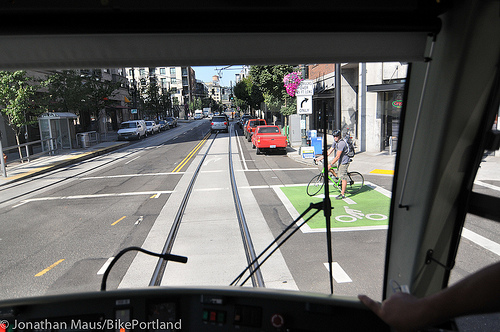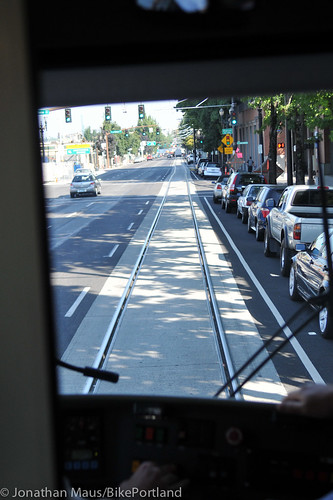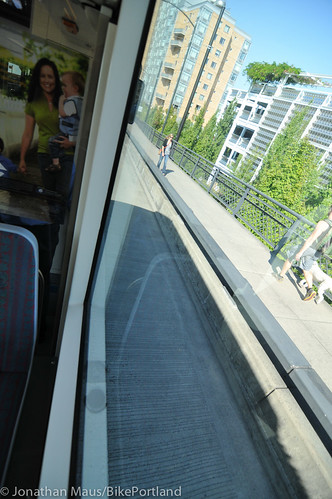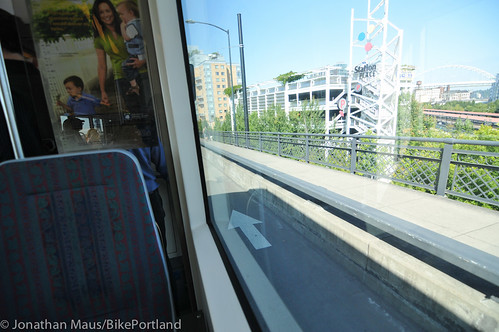
(Photos © J. Maus/BikePortland)
This morning I took a ride on the new, $148 million eastside streetcar line. PBOT and Portland Streetcar Inc. (the non-profit that runs the system) set up the event as a way for local journalists to get an up-close look at the new line and get questions answered by planners and insiders.
While on the ride, there were a few things I was curious about: How it will compete with bicycling and driving in the quest for transportation consumers? How will the physical presence of the streetcar (and its tracks) impact bicycling along the line? How convenient will it be to take bikes on-board?
We began our trip at NW 9th and Lovejoy. Total time for us to get down to OMSI (about three miles) was about 30 minutes. Despite being slower than I’m used to, the trip was safe, smooth, scenic and air-conditioned — attributes I can’t claim on a similar bike trip. Going over the Broadway Bridge, the operator slowed to an almost crawl (around 5 mph) through the middle section. It was so slow that several bikes easily passed and cars went by like we were standing still. But other than that, the streetcar kept a nice pace up Weidler, through the Lloyd District, and then down to OMSI.
While traveling down the right-most lane of Martin Luther King Jr Blvd and back up on Grand, I couldn’t help but recall that I used to use those lanes when I had an office in the central eastside. Riding up MLK and down Grand was unfortunately the quickest, most direct way for me to get home in north Portland. With the streetcar tracks and other infrastructure now in those right lanes, riding on these streets is even more scary than it used to be.
I asked Rick Gustafson, long-time executive director of Portland Streetcar Inc., about that and other bike-related issues. But before I talked with him, I overheard him talking to other reporters about how important and transformative he feels the streetcar will be.
“This will shape the city for the next 100 years,” he said, “Over the long-term it’s going to bring great benefits.” He spoke about how streetcar encourages not just development and density, but the kind that makes places. “It’s a vitality catalyst,” he proclaimed and spoke about how the mix of residential and commercial development that is coming — and will come — along the line will create pleasant places to walk. Gustafson referred to streetcar as a “walk extender.” Once up and running, he said the new line will connect people on foot with 163 restaurants.
As for ridership, Gustafson tamped down expectations, saying that it’s a new line, so it could take a while to build ridership. At this point, they estimate the new line will add about 4,000 to 5,000 new riders per day to their system (which currently serves 11,000 people on the west side of the river alone). Another interesting stat related to ridership is that 80% of transit riders in the region cross through the new streetcar line.
On that note, I asked Gustafson how someone would take their bike on board. “The bikes are perfectly welcome,” he said. The cars don’t have hooks or designated bike areas like MAX trains do, but bikes are allowed on the main boarding area of the streetcar. “Every space we have here is shared,” he said, “This space down here [the lower portion with room for people in wheelchairs and so on] is universally available.” Gustafson said bike hooks would run counter to that shared space philosophy. “Putting a hook up somewhere would create interference and would tend to create entitlement to one use.”
The largest issue with bikes and streetcars in Portland are the high number of crashes that happen when people get their tires caught in tracks. On that topic, Gustafson didn’t really have any good answers. “The tracks are always a threat to bikes,” he said. Beyond the tracks, asked how the streetcar impacts bicycling overall, Gustafson chose his words carefully: “We’re very committed to making sure that there is a safe route and safe opportunity for all bikes in the system. We did a lot of work in the Pearl [District] with the 9th Avenue turn and improving Marshall for bikes and creating the bike boulevard concept in the Pearl.”
To make room for the new streetcar line, PBOT and Portland Streetcar decommissioned the popular Lovejoy bike lane and have tried to route all bike traffic to NW Marshall — a side-street one block over. Not only is the re-route not working (people still use Lovejoy, to their peril), but Marshall should never be mistaken for a bike boulevard. When I told Gustafson that the current design of Marshall is flawed (it has a lot of auto volume and isn’t an efficient bikeway), he said they’ll continue to work in it and that, “That’s all part of the whole process of figuring out how to live together.” (Turns out he personally didn’t like the Lovejoy bike lane to begin with.)
Another place where the streetcar has impacted bicycling is on the MLK/Grand couplet (as I mentioned above). When I shared with Gustafson that a difficult place to ride is now even worse with the of addition of the streetcar, he dismissed the concerns by saying, “I thought it was difficult to bike there regardless.” He quipped that the “strong and fearless” riders, or what he calls “the immortals” still wouldn’t have any problem riding on MLK and Grand because, “They’d take any lane.”
As for how the forthcoming bike share system will impact and integrate with the new streetcar line, Gustafson said he feels the streetcar will help it succeed. Streetcar will promote density he said, and density is a key ingredient for bike share success.
As we rolled back into the Pearl District, I was curious how the new streetcars would fit onto the Lovejoy ramp west of the Broadway Bridge (we’ve already reported how the tracks cause people in cars to straddle them and drift over into the bike lane). From my perch inside the car, I couldn’t even see the outside of the bike lane striping. It’s a very snug fit between the steel exterior of the streetcar and the bike lanes. I’m curious how it will feel to someone to be biking down (or up) NW Lovejoy and have a multi-ton steel train a few inches from one of your elbows and a concrete wall next to the other. Have a look…
Despite my concerns, I think/hope the streetcar will be a good thing overall for the eastside because it gives people another option to driving. Stay tuned for more coverage once the new “Loop” opens to the public on September 22nd.






